|
Ancient Jewelry
|
|
 |
|
 |
|
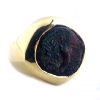
Price :
$3700.00
Origin: Jerusalem, Israel
Circa: 40 BC to 37 BC
Collection: Jewelry
Style: Jewish Coin Rings
Medium: Bronze-Gold
The last of the Hasmonean dynasty that ruled ancient More »
Origin: Jerusalem, Israel
Circa: 40 BC to 37 BC
Collection: Jewelry
Style: Jewish Coin Rings
Medium: Bronze-Gold
The last of the Hasmonean dynasty that ruled ancient Israel for almost a century, Mattathias Antigonus was a remarkable personality. Though his brief reign was filled with political struggle, his coinage focuses on images of peace and abundance. On this bronze coin, an inscription reading “Mattathias The High Priest And The Hever Of The Jews†surrounds a cornucopia representing wealth and plenty. Set in a ring of bright gold, it evokes a pivotal era in history. To wear this splendid jewel today is to link ourselves to the lives of the men and women who first held this coin centuries ago. - (FJ.3351) « Less
|
|
Ancient Jewelry
|
|
|
|
|
| Vendor Details |
Close |
| Contact Info : |
| Barakat Gallery |
| 405 North Rodeo Drive |
| Beverly Hills |
| California-90210 |
| USA |
| Email : barakat@barakatgallery.com |
| Phone : 310.859.8408 |
|
|
|
|
|
|

Price :
$2400.00
Origin: Israel (Jerusalem)
Circa: 66 AD to 70 AD
Collection: Coin Jewelry
Medium: Bronze/Gold
Additional Information: This inspiring coin is set in an 18 karat gold More »
Origin: Israel (Jerusalem)
Circa: 66 AD to 70 AD
Collection: Coin Jewelry
Medium: Bronze/Gold
Additional Information: This inspiring coin is set in an 18 karat gold ring.
The men and women who first held and used this coin shared a dream of freedom. Minted centuries ago in a time of struggle, the coin bears imagery that looks forward to an age of peace and abundance. When we hold it today, we feel the power of those ancient dreams, the hopes and desires of people who valued freedom enough to fight for it. In a frame of radiant gold, this splendid token celebrates the past but also looks forward to the future. - (FJ.3432) « Less
|
|
Ancient Jewelry
|
|
|
|
|
| Vendor Details |
Close |
| Contact Info : |
| Barakat Gallery |
| 405 North Rodeo Drive |
| Beverly Hills |
| California-90210 |
| USA |
| Email : barakat@barakatgallery.com |
| Phone : 310.859.8408 |
|
|
|
|
|
|
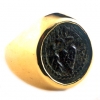
Price :
$2700.00
Origin: Jerusalem, Israel
Circa: 4 BC to 6 AD
Collection: Jewelry
Style: Jewish Coin Ring
Medium: Bronze/Gold
Additional Information: This gorgeous coin is set in an 18 More »
Origin: Jerusalem, Israel
Circa: 4 BC to 6 AD
Collection: Jewelry
Style: Jewish Coin Ring
Medium: Bronze/Gold
Additional Information: This gorgeous coin is set in an 18 karat gold ring.
This gorgeous coin is set in an 18 karat gold ring. Like a ticket on a time machine, an ancient coin allows the imagination to take flight across the centuries. Though coins in antiquity were often artistically beautiful, they were nonetheless ordinary objects, passed hand to hand in the streets and markets. From such a small token as this we can imagine an individual who might have held it, a place, a time, an entire vanished world. To wear this bronze coin in its radiant setting of gold is to take the mind on an endless journey of discovery. - (FJ.3434) « Less
|
|
Ancient Jewelry
|
|
|
|
|
| Vendor Details |
Close |
| Contact Info : |
| Barakat Gallery |
| 405 North Rodeo Drive |
| Beverly Hills |
| California-90210 |
| USA |
| Email : barakat@barakatgallery.com |
| Phone : 310.859.8408 |
|
|
|
|
|
|

Price :
$4600.00
Origin: Jerusalem, Israel
Circa: 132 AD to 133 AD
Collection: Jewelry
Style: Jewish Coin Rings
Medium: Bronze-Gold
Sixty-two years after the destruction of the second More »
Origin: Jerusalem, Israel
Circa: 132 AD to 133 AD
Collection: Jewelry
Style: Jewish Coin Rings
Medium: Bronze-Gold
Sixty-two years after the destruction of the second temple, the second major war against the Romans broke out--the bar Kokhba revolt. Carefully and secretly prepared, this war was prompted by Hadrian’s wish to install Greco- Roman culture with even greater force. The spiritual leader of the revolt was Rabbi Akiva, while the military and civil leader was Simeon bar Koseva (Shimon bar Kokhba). This war was much fiercer than the first Jewish revolt, and the Romans were initially hard pressed. The twenty - second legion was defeated and completely wiped out and Hadrian, in his report to the senate at the end of the war, even omitted the customary mention of the army's well being. The exact extent of the territory controlled by bar Kokhba is not quite clear, but he certainly held the Hebron district, part of Idumea and the Dead Sea region (where the last of his fighters took shelter in desert caves). It is still not known for certain if he indeed took Jerusalem, if only for a short time. The last major stand was at Bethar, and the war came to an end following bar Kokhba's death there. From his coins, and from the documents found in the Judean desert, it is known that bar Kokhba styled himself nasi (prince) of Israel. The coins of this revolt constitute the last ancient Jewish coinage and it is quite remarkable that in that hour of bitter struggle and dire peril, the Jews took pains to mint the most pleasing series of coins ever issued in that country. Bar Kokhba had learned from the Romans how to utilize coinage as a means of mass propaganda; hence the nationalistic motifs and slogans that appear on the coins. On one side of this distinctive coin appears a palm tree, symbolic of fruitful abundance, with an inscription that reads, "Jerusalem." the reverse side of the coin depicts an abstract image of a grape cluster, with an inscription reading "for the redemption of Israel." to wear this extraordinary coin, set in a radiant gold ring, is to share a powerful emotion with the people who first used the coin so many centuries ago. - (FJ.5159) « Less
|
|
Ancient Jewelry
|
|
|
|
|
| Vendor Details |
Close |
| Contact Info : |
| Barakat Gallery |
| 405 North Rodeo Drive |
| Beverly Hills |
| California-90210 |
| USA |
| Email : barakat@barakatgallery.com |
| Phone : 310.859.8408 |
|
|
|
|
|
|

Price :
$3600.00
Origin: Jerusalem
Circa: 132 AD to 135 AD
Collection: Coin Jewelry
Style: Jewish Coin Rings
Medium: Bronze and Gold
Sixty-two years after the destruction of the second More »
Origin: Jerusalem
Circa: 132 AD to 135 AD
Collection: Coin Jewelry
Style: Jewish Coin Rings
Medium: Bronze and Gold
Sixty-two years after the destruction of the second temple, the second major war against the Romans broke out--the bar Kokhba revolt. Carefully and secretly prepared, this war was prompted by Hadrian’s wish to install Greco- Roman culture with even greater force. The spiritual leader of the revolt was Rabbi Akiva, while the military and civil leader was Simeon bar Koseva (Shimon bar Kokhba). This war was much fiercer than the first Jewish revolt, and the Romans were initially hard pressed. The twenty - second legion was defeated and completely wiped out and Hadrian, in his report to the senate at the end of the war, even omitted the customary mention of the army's well being. The exact extent of the territory controlled by bar Kokhba is not quite clear, but he certainly held the Hebron district, part of Idumea and the Dead Sea region (where the last of his fighters took shelter in desert caves). It is still not known for certain if he indeed took Jerusalem, if only for a short time. The last major stand was at Bethar, and the war came to an end following bar Kokhba's death there. From his coins, and from the documents found in the Judean desert, it is known that bar Kokhba styled himself nasi (prince) of Israel. The coins of this revolt constitute the last ancient Jewish coinage and it is quite remarkable that in that hour of bitter struggle and dire peril, the Jews took pains to mint the most pleasing series of coins ever issued in that country. Bar Kokhba had learned from the Romans how to utilize coinage as a means of mass propaganda; hence the nationalistic motifs and slogans that appear on the coins. On one side of this distinctive coin appears a palm tree, symbolic of fruitful abundance, with an inscription that reads, "Jerusalem." the reverse side of the coin depicts an abstract image of a grape cluster, with an inscription reading "for the redemption of Israel." to wear this extraordinary coin, set in a radiant gold ring, is to share a powerful emotion with the people who first used the coin so many centuries ago. - (FJ.5168) « Less
|
|
Ancient Jewelry
|
|
|
|
|
| Vendor Details |
Close |
| Contact Info : |
| Barakat Gallery |
| 405 North Rodeo Drive |
| Beverly Hills |
| California-90210 |
| USA |
| Email : barakat@barakatgallery.com |
| Phone : 310.859.8408 |
|
|
|
|
|
|
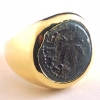
Price :
$2700.00
Origin: Israel
Circa: 66 AD to 70 AD
Collection: Jewelry
Style: Jewish Coin Ring
Medium: Bronze-Gold
The dissatisfaction of the people during the period of Roman More »
Origin: Israel
Circa: 66 AD to 70 AD
Collection: Jewelry
Style: Jewish Coin Ring
Medium: Bronze-Gold
The dissatisfaction of the people during the period of Roman procuratorial rule in Judea led from time to time to outbreaks and bloodshed, and to their suppression by the Roman legions. In 66 A.D., serious rioting broke out at Caesarea, which soon spread. The Jews quickly gained the upper hand and the roman occupation forces were driven out of much of the country, which encouraged the population to openly oppose the roman army. For the next several years, a bitter war was waged in Judea between the Jewish inhabitants and the Roman legions, with the latter slowly regaining the positions they had lost at the beginning of the revolt. Nero, the emperor at the time the war began, sent the general Vespasian to command the roman forces. He reconquered the northern part of the country and then laid siege to Jerusalem. On the ninth of Av, 70 A.D., the second temple was destroyed. By this time, Vespasian had already been proclaimed emperor in Rome, and his son, Titus, had taken over as commander. Many thousands were killed in the fighting and, when the temple fell, aspirations for Jewish independence faded for generations. The coins issued during this dramatic period in history carry "revolutionary" slogans as well as depictions of symbols that are characteristically Jewish. This distinctive coin features the image of a vine leaf, evoking the peaceful abundance that the leaders of the revolt so fervently longed for. The reverse side of the coin portrays a holy chalice. In its frame of radiant gold, this expressive coin stands as a timeless and significant symbol of age-old ideals and ongoing faith. - (FJ.5181) « Less
|
|
Ancient Jewelry
|
|
|
|
|
| Vendor Details |
Close |
| Contact Info : |
| Barakat Gallery |
| 405 North Rodeo Drive |
| Beverly Hills |
| California-90210 |
| USA |
| Email : barakat@barakatgallery.com |
| Phone : 310.859.8408 |
|
|
|
|
|
|
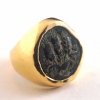
Price :
$1400.00
Origin: Israel
Circa: 37 AD to 44 AD
Collection: Coin Jewelry
Style: Jewish Coin Rings
Medium: Bronze-Gold
Born about 10 B.C., Agrippa I was the grandson of Herod the More »
Origin: Israel
Circa: 37 AD to 44 AD
Collection: Coin Jewelry
Style: Jewish Coin Rings
Medium: Bronze-Gold
Born about 10 B.C., Agrippa I was the grandson of Herod the Great and his wife, Mariamne the Hasmonean, through whose blood he was linked to the earlier kings of Israel. His father Aristobolus was executed on Herod’s orders about 7 B.C. to ensure his support of Rome, the young prince Agrippa was educated at the imperial court, where he became friends with the future emperors Caligula and Claudius. Through these roman imperial connections, Agrippa was eventually granted kingship over the Jewish territories of his late uncles. At its peak, his kingdom equaled that of his grandfather Herod. Agrippa became religiously observant and was honored by his subjects. He died suddenly at Caesarea in 44 A.D.This dramatic coin was struck during the reign of Agrippa, intended for use in Judea. On one side it bears three ears of barley growing between two leaves, the barley symbolizing the Greek earth mother goddess Demeter. On the other side a fringed canopy appears, signifying Agrippa’s high rank as a ruler over and above territories which were ruled by mere kings. The umbrella image was taken from Persia where the high king sat during his audiences, sheltered beneath an umbrella. Mounted in a beautiful gold ring setting, this bronze coin is a dramatic and tangible link with the ancient heritage of the western world. - (FJ.5291) « Less
|
|
Ancient Jewelry
|
|
|
|
|
| Vendor Details |
Close |
| Contact Info : |
| Barakat Gallery |
| 405 North Rodeo Drive |
| Beverly Hills |
| California-90210 |
| USA |
| Email : barakat@barakatgallery.com |
| Phone : 310.859.8408 |
|
|
|
|
|
|
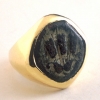
Price :
$3400.00
Origin: Israel
Circa: 37 AD to 44 AD
Collection: Jewelry
Style: Jewish Coin Rings
Medium: Bronze and Gold
Born about 10 B.C., Agrippa I was the grandson of Herod the More »
Origin: Israel
Circa: 37 AD to 44 AD
Collection: Jewelry
Style: Jewish Coin Rings
Medium: Bronze and Gold
Born about 10 B.C., Agrippa I was the grandson of Herod the great and his wife, Mariamne the Hasmoneans, through whose blood he w as linked to the earlier kings of Israel. His father Aristobulus was executed on Herod's orders about 7 B.C. To ensure his support of Rome, the young prince Agrippa was educated at the imperial court, where he became friends with the future emperors Caligula and Claudius. Through these Roman imperial connections, Agrippa was eventually granted kingship over the Jewish territories of his late uncles. At its peak, his kingdom equaled that of his grandfather Herod. Agrippa became religiously observant and was honored by his subjects. He died suddenly at Caesarea in 44 A.D. Agrippa struck two types of coins: the first was intended for Judea and bears a canopy and ears of barley, as revealed in this stunning example; the other type w as intended for those areas under his control where the majority of the population was non-Jewish, and these coins therefore display a more pagan character. The latter bear the portrait of Claudius, a temple and a quadriga. Agrippa was the first of the Herodian kings who dared to strike his own portrait on his coins; on several he styles himself king Agrippa the great, friend of Caesar. - (FJ.5325) « Less
|
|
Ancient Jewelry
|
|
|
|
|
| Vendor Details |
Close |
| Contact Info : |
| Barakat Gallery |
| 405 North Rodeo Drive |
| Beverly Hills |
| California-90210 |
| USA |
| Email : barakat@barakatgallery.com |
| Phone : 310.859.8408 |
|
|
|
|
|
|
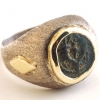
Price :
$1800.00
Origin: Israel
Circa: 76 BC to 40 BC
Collection: Jewelry
Style: Jewish Coin Ring
Medium: Bronze-Gold
Additional Information: This Genuine Ancient Coin Has Been Set in a More »
Origin: Israel
Circa: 76 BC to 40 BC
Collection: Jewelry
Style: Jewish Coin Ring
Medium: Bronze-Gold
Additional Information: This Genuine Ancient Coin Has Been Set in a Modern 18 karat Gold Ring
With the decline in power of the ruling Seleucid dynasty of Syria in the second century B.C., the Hasmoneans began to assert a greater political independence for the Jewish people. Upon the death of Alexander Janaeus in 76 B.C., his widow Salome Alexandra took over the reign of power. However, because a woman could not hold the office of high priest, this title was given to her son by Jannaeus, John Hyrcanus II. When Salome died in 67 B.C., a civil war broke out between Hyrcanus and his brother Aristobulus II which lasted four years, until the Roman general Pompey intervened. Pompey then conquered Jerusalem but left the powers of John Hyrcanus as high priest intact. From this time onward, the Romans took an active hand in the political affairs of Judea. One of John Hyrcanus' chief advisors was Antipater the Idumean who saw that his own son Herod was eventually installed on the throne after the death of Hyrcanus in 40 B.C. - (FJ.5397) « Less
|
|
Ancient Jewelry
|
|
|
|
|
| Vendor Details |
Close |
| Contact Info : |
| Barakat Gallery |
| 405 North Rodeo Drive |
| Beverly Hills |
| California-90210 |
| USA |
| Email : barakat@barakatgallery.com |
| Phone : 310.859.8408 |
|
|
|
|
|
|

Price :
$3100.00
Origin: Israel (Jerusalem)
Circa: 103 BC to 76 BC
Collection: Jewish Coin rings
Medium: Bronze/Gold
Additional Information: This superb coin is set in an 18K gold More »
Origin: Israel (Jerusalem)
Circa: 103 BC to 76 BC
Collection: Jewish Coin rings
Medium: Bronze/Gold
Additional Information: This superb coin is set in an 18K gold ring
In the images, symbols and words that adorn ancient coins, we read of the hopes and dreams of men, the rise and fall of empires, the comings and goings of kings and queens. Along with this public history is a more intimate, private one, having to do with the people through whose lives this particular coin once passed. This lovely coin glows with the touch of vanished hands, unseen perhaps, but as real as the patina of age. Under the Hasmoneans dynasty, Ancient Israel achieved a remarkable degree of political and cultural independence. This token of that era helps us cross the bridge of time. To wear it in its golden setting is to link us with the unbroken chain of human history. - (FJ.5636) « Less
|
|
Ancient Jewelry
|
|
|
|
|
| Vendor Details |
Close |
| Contact Info : |
| Barakat Gallery |
| 405 North Rodeo Drive |
| Beverly Hills |
| California-90210 |
| USA |
| Email : barakat@barakatgallery.com |
| Phone : 310.859.8408 |
|
|
|
|
|
|
|
|

|


